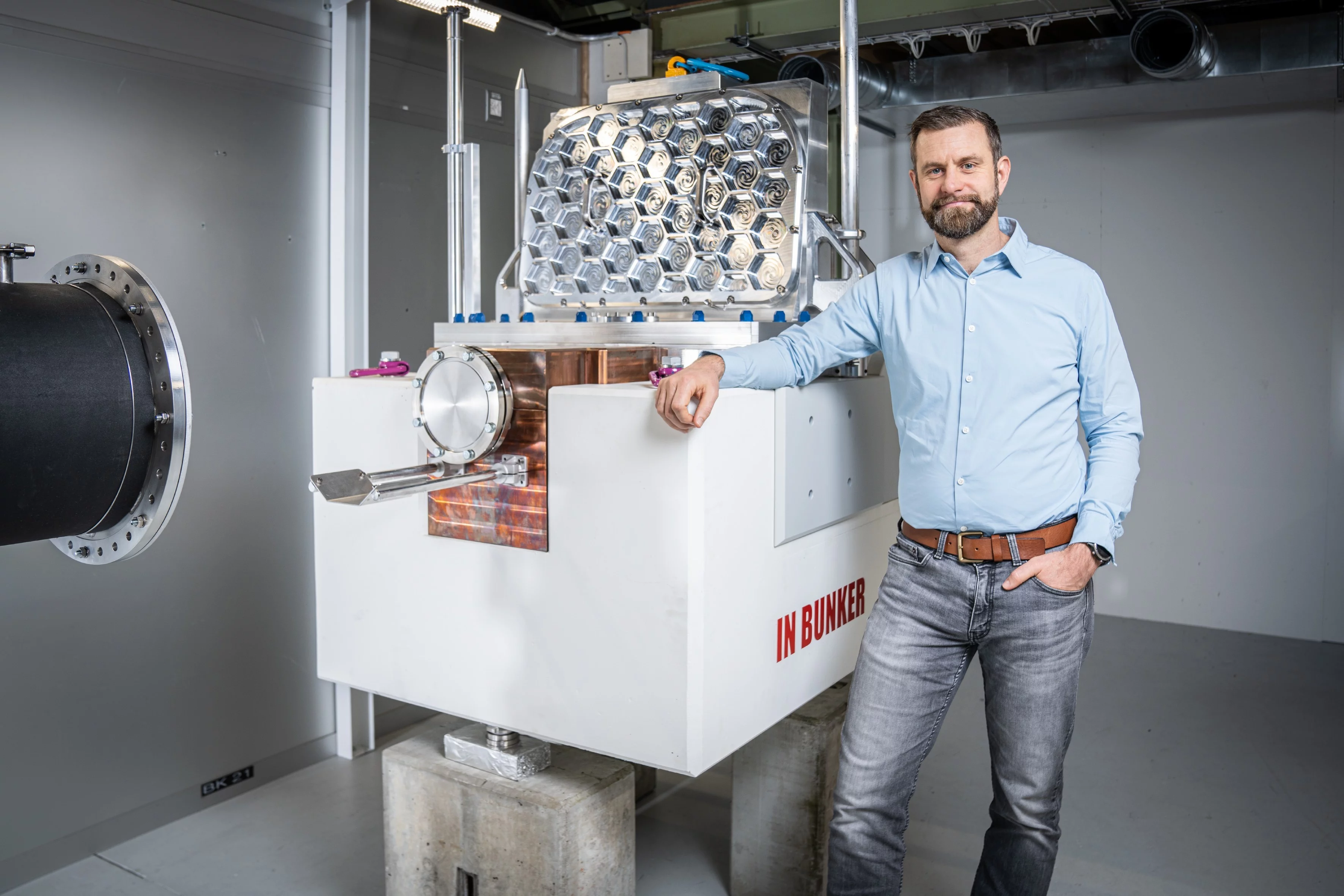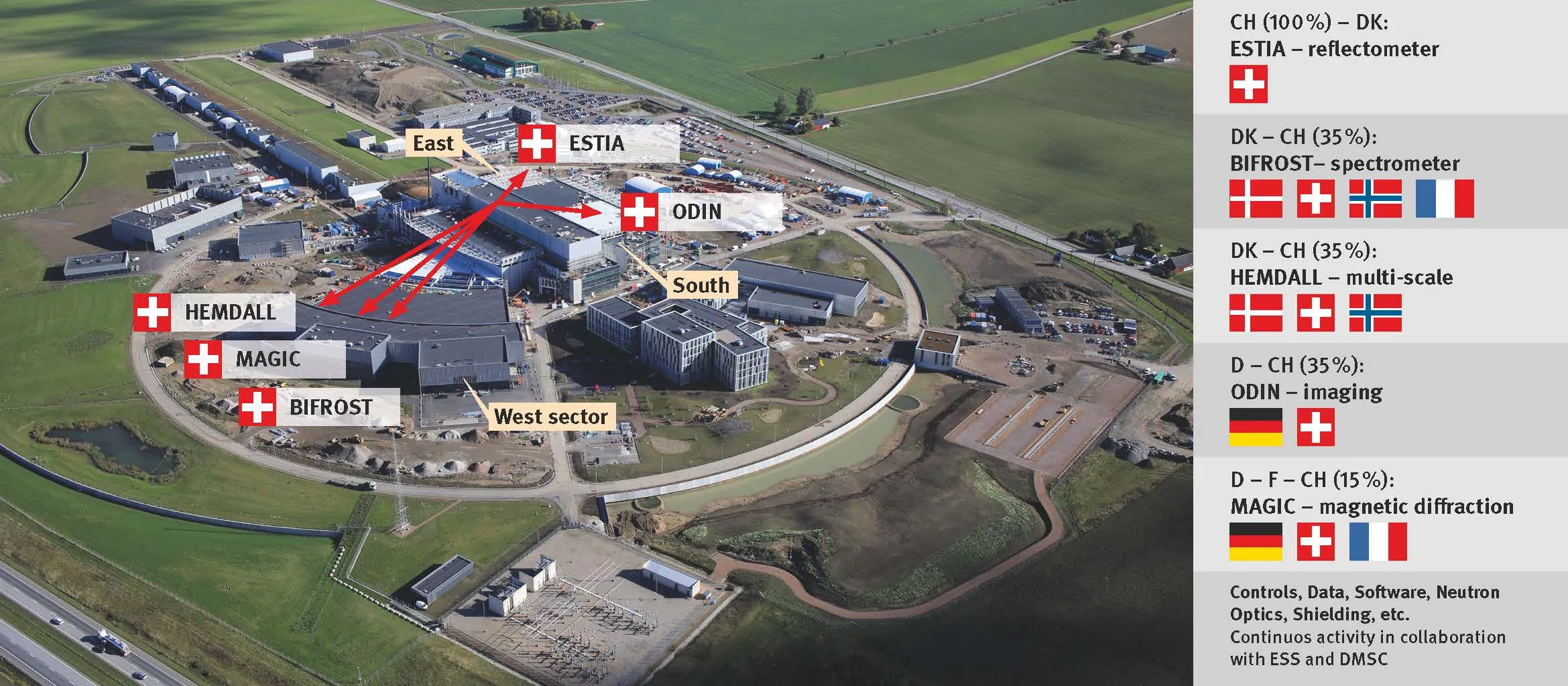Planning and building a large-scale research facility such as the European Spallation Source ESS presents unique challenges. Physicist Marc Janoschek explains why only those who overcome them can achieve breakthroughs in research.
(Photo: Paul Scherrer Institute/Mahir Dzambegovic)
(Photo: Perry Nordeng/ESS-Graphic: Paul Scherrer Institute)
In general terms, what is the significance of your involvement in the European Spallation Source ESS project in Lund, Sweden?
Marc Janoschek: The project is of great interest both to PSI and to Switzerland as a whole. At PSI, we operate the Swiss Spallation Neutron Source SINQ, which is the national neutron source for Switzerland but is also of international importance. SINQ is a continuous neutron source, which makes it quite special. In terms of the intensity of the neutron beam, we are in the upper midfield compared to other international sources. However, we are world leaders, for example, in making optimal use the produced neutrons through innovative instrumentation, in offering the experimental boundary conditions required by our international users, such as high and low temperatures, high pressures and magnetic fields for their samples, and in creating an ideal environment for the experiments, or in focusing neutron beams on the samples. We are in great demand internationally as a collaboration partner. By participating in the ESS, we are now also gaining access to the world’s strongest neutron source so that, on the one hand, we can contribute our expertise and, on the other hand, conduct our own experiments there.
So this means that the two spallation sources SINQ and ESS are not in competition with each other?
On the contrary, they complement each other perfectly. We are involved in the design of many of the ESS beamlines, where we build on techniques and processes developed for SINQ, for example at ESTIA, Bifrost or Odin. Researchers who start a project at PSI can thus go on to work on the ESS in a straightforward fashion when in need of a stronger spallation source. Swiss researchers in particular benefit from this. However, our involvement also makes PSI more competitive as an international cooperation partner.
Given that Switzerland is now limited to third-country status in the EU’s major research funding programme Horizon Europe, how important is involvement in the ESS project for PSI and Swiss research?
Switzerland’s downgrade to third-country status has no direct influence on this project. Indirectly, though, it is significant because we can no longer participate in projects funded by Horizon Europe, at least not as a leading institution. However, the ESS project is also a clear demonstration that such large undertakings can no longer be tackled by a single country and that we urgently need international cooperation. This being so, there is an urgent need for Switzerland and the EU to find a means of mutually beneficial cooperation. Fifteen instruments are being built at the ESS. We are involved in five and building one all by ourselves. This shows that Swiss expertise is in demand.
What new findings are you hoping from the ESS project?
Currently, one challenge in neutron research is that we still need comparatively large samples in order for our experiments. But when we want to research new materials for new applications – for example, materials for quantum technologies – these are often so small as to be barely visible to the naked eye. The same applies to the study of membranes or proteins. Unlike X-rays, neutrons react very sensitively to light elements such as hydrogen or carbon, which provides valuable structural information for understanding cancer, neuro-degenerative diseases such as Alzheimer’s or even targeted drug delivery. We have already made great progress in the investigation of tiny samples at SINQ, but a spallation source like the ESS will further expand our capabilities to a tremendous degree. The higher neutron flow of the ESS will also make time-resolved experiments the standard, as we are already testing on the SINQ. This can be used, for example, to study the transport of hydrogen and lithium in energy materials. We can also exploit it to study samples under extended experimental conditions, such as even higher pressure, very strong magnetic fields, very low or very high temperatures, or even combinations of these, which will deliver significant progress in many research areas.
So first you develop new methods, which is a very lengthy process in itself. The results come much later. What is it like to work on such long-term projects?
The time scales for such large projects are very long. That’s still the case even in these fast-moving times. But that is precisely the challenge that makes it so special to be involved. We have to think decades ahead. Planning and building a facility like the ESS takes almost twenty years from the initial concept to full realisation. When the instruments see the first neutrons, fine adjustments still have to be made so that the facility can develop its full potential. The big successes and breakthroughs only come later, but they will come – of that I am sure.
Interview: Sebastian Jutzi
Further information
- The European Spallation Source ESS
- Laboratory for Neutron and Muon Instrumentation
- The world’s most powerful neutron microscope
Contact
Prof. Marc Janoschek
Deputy head ad interim of the Research with Neutrons and Muons Division
Head of the Laboratory for Neutron and Muon Instrumentation
Paul Scherrer Institute, Forschungsstrasse 111, 5232 Villigen PSI, Switzerland
Telephone: +41 56 310 49 87, e-mail: marc.janoschek@psi.ch
Copyright
PSI provides image and/or video material free of charge for media coverage of the content of the above text. Use of this material for other purposes is not permitted. This also includes the transfer of the image and video material into databases as well as sale by third parties.


